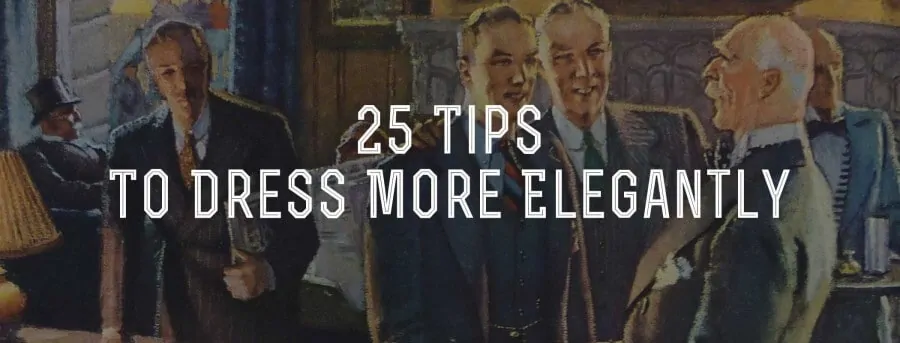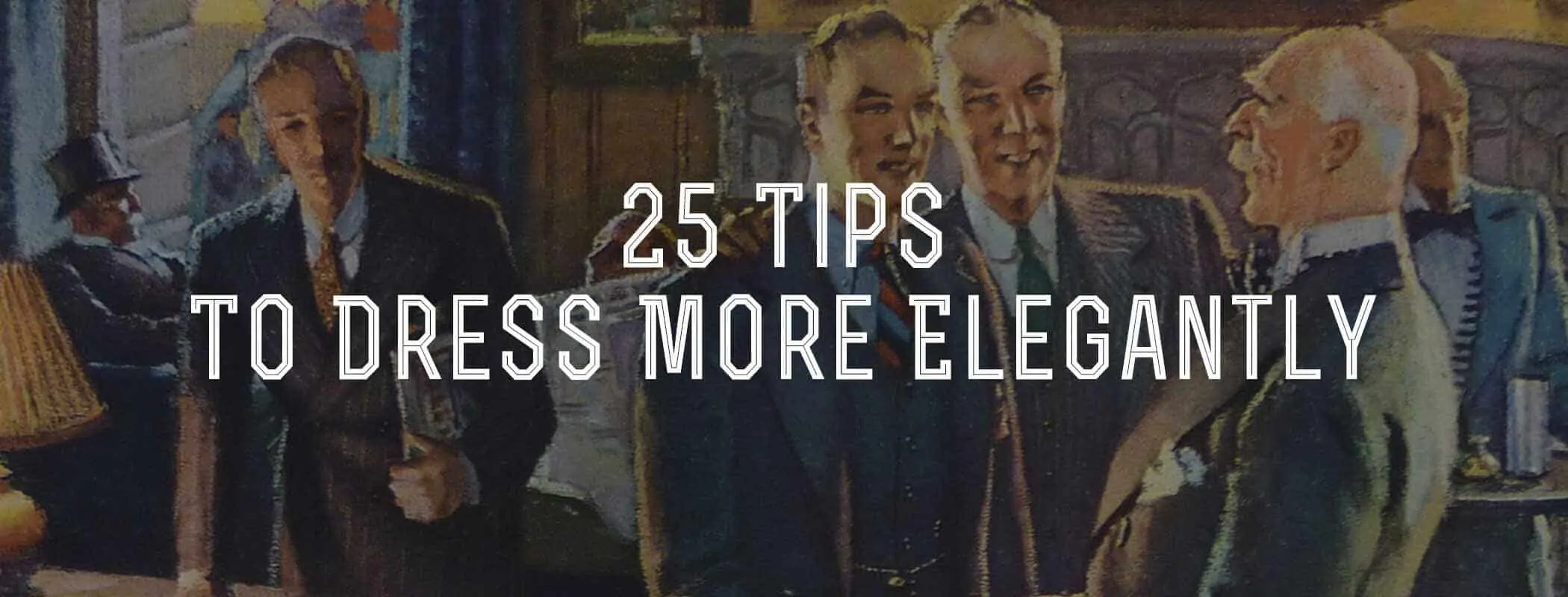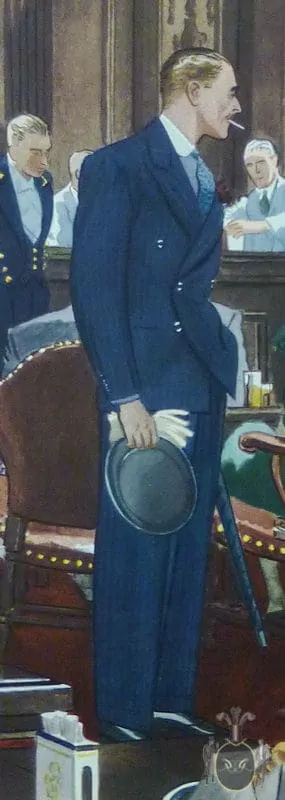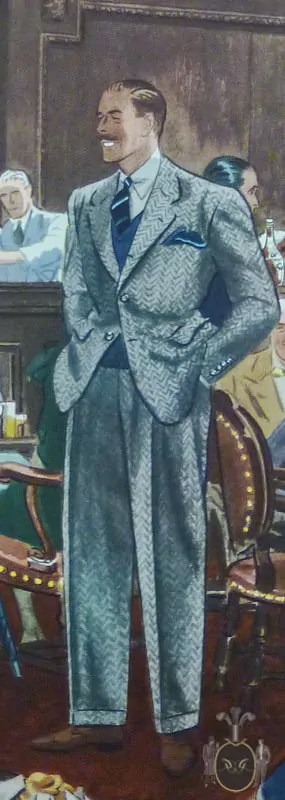
Yesterday, I came across a post about the “25 pieces of basic sartorial knowledge” that every man should purportedly have. Since it was listed as a great post, I wanted to take a look at this guide of dress etiquette myself.
While the article creates some helpful rules for style beginners (no socks with sandals, etc.), we at the Gentleman’s Gazette know that you’ve already mastered the basics and are interested in taking your style to the next level of expression, precision, and elegance. Your clothes make a statement about you, and these simplified guidelines no longer apply. Since we pride ourselves on our attention to detail, I thought I would respond with my very own 25 Tips to Dress More Elegantly that are appropriate for the Apparel Arts-inclined. Our list will focus on our house specialty, the elements of classic style – suits, tuxedos, jackets and the corresponding accessories. While you will see a slight overlap with the original list, we hope you’ll find these useful.
25 Tips On How to Take Your Style from Put Together to Elegant
- On almost all single breasted jackets, leave the bottom button unbuttoned, unless you have a paddock jacket. On double breasted jackets, you should generally button the bottom one unless you want to express some sprezzatura and wear your coat like Lino Ieluzzi from Al Bazar.
- Unbutton the bottom button of your vest, unless it is double-breasted or an evening waistcoat.
- Avoid wearing visible logos, especially when formally attired; you are a vehicle for your own style identity, and your choices should further your expression rather than the brand’s.
- Clip visible loose threads or labels, and open tacked pockets and vents with a seam ripper. A double edge razor blade is useful for trimming very close to the fabric surface.
- Don’t leave the house without a quick once-over with a fabric brush. Trash the tape lint roller, and invest in a good brush – you won’t regret it.
- While two or three buttons on a single-breasted jacket are today’s standard, a tuxedo should have just one button and even a sports coat can look great with just one button. Four buttons are great on a safari jacket or anything else that you want to button all the way up.
- On single breasted three-button jackets, button just the center button or additionally the top button – take a look at the mirror and wear what feels more comfortable. See Tip #1.
- If you wear a black belt, it’s standard to black shoes. Brown shoes are much more flexible; brown is always an option, but don’t shy away from more irreverent choices, such as a necktie or a multicolor belt in warmer seasons, as Fred Astaire has shown us.
- Choose to wear either a belt or suspenders, but not both. Neither may be worn if your trousers are tailored with a half-belt in the back or side adjusters. Vests may be worn with the latter two choices, but never with a belt. See Roger Sterling.
- Most men look best if they display between half an inch and an inch of shirt cuff underneath their jacket sleeves. For a harmonious look, try to match the visible cuff length to the amount of collar that is visible at the back of the neck.
- Most men in the US wear their pants too long. Ideally, full cut trousers should reach the shoe and create a slight or half break. Trousers with cuffs can be worn a little shorter and the same is true for tapered trousers. There’s no cause for concern if you observe Tip #22.
- When you buy a jacket off the rack, make sure the shoulders of the coat at the sleeve head are just a tad wider than your natural shoulders. Most alterations tailors will have difficulties properly altering the shoulders.
- Ready-to-wear suits need to be altered. I have NEVER seen a suit off the peg that fits perfectly without alterations. So, even if you think you’ve scored a lucky find, make it a habit to bring every new purchase to your alterations tailor, and see what they have to say.
- It is often said that your tie should reach the waistband of your trousers. Any man with a classically oriented wardrobe has a variety of trouser rises to contend with, and just because your wear low cut pants does not mean your tie should be longer. However, a necktie rarely looks great when it extends beyond the waistband. When in doubt, I always go a little shorter.
- A tie has no functional use. It is purely decorative and therefore it should look good. A dimple or two in your tie knot will most likely improve your overall appearance.
- Avoid letting your tie knot slip – as Tip # 15 describes, this decorative accessory is a visual focal point that can put you at risk of looking – the horror – sloppy if not properly attended.
- When you wear a tie, you should always pair it with either a vest, a suit, a jacket or a cardigan. A shirt and tie alone, especially short-sleeved shirts, looks very unfortunate.
- Black suits should be reserved for the evenings and funerals. Alternatively, buy a tuxedo and a Stroller Suit and skip the black suit altogether.
- Avoid combining a pocket square and tie made from the same cloth because it looks cheesy.
- Do not pin your boutonniere on your lapel – not only will it leave holes in the fabric, but they have an unfortunate tendency to sag. Use your buttonhole and a loop on the back of your lapel instead.
- Make sure the heels and tips of your leather-soled dress shoes well maintained and are kept in regular polish. If you bring your shoes to the cobbler on time, it will be less expensive, and your shoes will last much longer.
- When wearing a suit, make sure always to wear over-the-calf socks, since nobody wants to see your hairy legs.
- If your shirt collar has a tendency to curl, wear collar stays.
- A white t-shirt or undershirt worn exposed under an open shirt collar will immediately cheapen your entire ensemble – avoid them, in general, as they are visible under virtually all shirts or get an undershirt that is invisible.
- If you wear a hat – which is great – take it off when you are inside unless you are at an airport or a similarly public place. At places of worship, different rules apply.
Do you have anything to add to this dress etiquette guide? Do you disagree? I look forward to hearing from you!



I agree with everything you say here, but I would like you to amend something you said about socks. I believe that sock suspeders (garters) may still be worn to prevent one’s hosiery from sliding down. Some of us find OTC’s quite uncomfortable.
Thank you.
Dear Roy,
Thanks for pointing out sock garters. I am surprised to hear that you apparently seem to find sock garters more comfortable than over the calf socks!
Very well articulated
Thank you Sajeel
Are you suggesting that a gentleman should wear a dress shirt without an undershirt or t-shirt? I cannot imagine anything more common.
Personally, I only wear a t-shirt underneath a starched shirt because it is otherwise to rough on the skin. If you want to wear t-shirts, ge some with deep necks so you cannot see the t-tshirt if you wear your shirt without a tie.
As a well dressed father of 5 young men, I like and agree with almost every one of your rules. I would just add the two following thoughts:
1. If I find occasion to wear a tie without a jacket, vest or sweater, I add a tie clip for a finishing touch. If it’s a bow tie I’m wearing, suspenders will finish off the look.
2. Undershirts hide body hair and absorb body odor (yes, you guys without undershirts on often stink and you also look pedestrian…like you dad forgot to teach you something), however, I do agree that the t-shirt should have a deep neck, and all of mine do. I think that only colored t-shirts should ever show above an open color as they are a nod to the men’s cravat of old.
Thanks for your thoughts and good luck.
Dear Derrik,
Thanks for your comment. If body hear pokes through a lightweight summer fabric, that’s indeed not ideal. However, I do not think that body odor has anything to do with wearing a t-shirt or not. The odor is the result of bacteria.
At last some tips that go into the deep of the matter. Thanks a lot for this enriching guide.
As to Tip No.17 I might add that short-sleeved shirts are after all generally not a choice to be taken, provided it won’t be a polo-shirt.
Actually, nontheless, I find the last one of the tips to be the most interesting, as nowadays, some seem to see headgear as a substitute for a proper hairstyle. Maybe one should add that that aswell taking it off before someone when saluting him or her, even when only passing, is not bad idea. I’ve remarked that people are a bit astonished when seeing it maybe for the first time ( as only proverbs seem to have conserved the idea of this gesture), but it will make for your charm.
Interesting observation about the hat.
Are you suggesting that a gentleman wear a dress shirt with no undershirt or t-shirt? Definitely not sartorially correct and certainly not elegant.
Dear Bespoke Lawyer,
Looking back in costume history, the undershirt or something similar seems to date back to the 9th century but later it disappeared and men wore just the shirt. In the 1870s the undershirt became the standard again.
In discussing things, we should bear in mind, that there are many occasions where different standards apply. While most men probably wear an undershirt or a T-Shirt underneath their shirt, it would be inadequate to wear one in a tropical environment, where the shirt cloth is so thin, that a T-Shirt would look ridiculous and be too warm.
As mentioned in the Guide, I think white t-shirts are rarely a great option. However, a t-shirt in skin color is infinitely preferable because you do not see it from the outside and it fulfills the same purpose.
The reason I wear an under-shirt is to protect the integrity of the shirt I am wearing, as they’re great barriers against naturally occurring oils on the body, but also protect the shirt from deodorant or anti-perspirant and my primary issue, sweat. Of course I do wear v-neck under-shirts exclusively. I don’t particularly enjoy wearing them as I am often too hot indoors, but they prevent the need to constantly launder and remove stains from a shirt, therein increasing the longevity of the shirt. Great article, Sven.
Thanks for your comment Brandon, I totally see your point, though just a v-neck t-shirt is usually not enough, since you will see it when wearing the top two shirt buttons unbuttoned. In my answer above, I address the heat issue as well. Personally, the areas that receive the most wear on my shirts are collars and cuffs and a t-shirt does not protect any of these :(.
In regards to rule #25, it’s mentioned that “at places of worship different rules apply.” Care to expand?
Bret I, Thanks for your comment. I will write a separate guide about headwear and elaborate on the matter then, otherwise it gets too fragmented.
I always wear an undershirt. Usually, I wear a white A-shirt/tank top/wife beater. But I recently started wearing white v-neck t-shirts. It seems odd to wear nothing under a dress shirt, even during the summer.
Love your website and don’t want to belabor the point but would you advocate not wearing underwear (boxers or briefs). At least to me, an undershirt is just as essential and should be worn at all times. Thanks again for a great site.
Dear Bespoke Lawyer,
Comments are always welcome, so don’t worry.
In my opinion, the parallel between boxers/briefs and underwear is not quite the same because on one’s legs, one only has boxers/briefs and trousers (2 layers). Some men will wear a front lining but that’s it.
On a torso, one can wear undershirt, shirt, jacket, and maybe overcoat (4 layers).
If you consider undergarments or shirts as a way of protecting your more precious outer garments, you could achieve that effect with just a shirt. Of course, you should wash the shirt after every time you wear it, but that goes without saying.
I am not saying no one should wear undergarments anymore. What I am saying is, that I can see situations where an undershirt is not necessary. Also, get t-shirt in skin color and do not wear white t-shirts, because white t-shirts show through the fabric.
After many years i have dumped the undershirt. This was with a heavy heart, but I find that, on balance, it has improved my look.
I mainly wear white dress shirts with french cuffs for work. I shed my jacket pretty quickly. This means that any undershirt is pretty visible through my shirt. Also, my building is pretty warm so an undershirt will make me too warm when wearing the entire undershirt, shirt, jacket ensemble. Hence, I now have a big stack of unused undershirts. My maud has even moved them to the back the chest of drawers, usually reserved for garments she finds garish.
The major drawback of not wearing an underhirt (be it T-shirt or tank top) is that I lose some of the whiteness of the white shirt. This is very unfortunatele, but so be it.
Thank you for your valuable comment Ian. I think the intensity of the white also has to do with the kind of shirt fabric. A sheer voile will look very different, than a 200gr/m twill.
Oh, sorry – great post Sven!
It is a god way to see the classic elegance…
I would like to clarify something in regard to dress shirts. A shirt, be it a dress shirt or a t-shirt is an undergarment. It is expected of a gentleman to change it every day in the same manner as he changes his boxers or whatever he uses under his trousers. Generally someone who wears a t-shirt under a dress shirt is trying to use a dress shirt more than once without washing it which is not very gentlemanly. If it’s really cold outside one must wear a warmer coat if one wishes to be elegant. However, in my humble opinion a gentleman may wear a t-shirt under his dress shirt as long as it isn’t ever visible but again this is almost impossible to achieve. If the gentleman has extreme body hair it is more desirable that it shows instead of a t-shirt. A dress shirt is an undergarment designed to be partially shown but the t-shirt is not. When it shows it is the same as when someone shows his underwear. A gentleman can choose not to wear any underwear including socks and there are many famous gents who never wore them. Of course we are referring to a classic gentleman. One can choose to be modern and dress elegantly casual as long as whatever outfit one chooses is in good taste but this requires even more je ne sais quoi to pull it off. I’ve seen men wearing polo shirts with jeans look more elegant than others in full suits.
Dear Ramon,
Thank you for your comment, I appreciate it because historically, the shirt is just an undergarment and you try to weigh up the pros and cons.
Your guides seem appropriate if one restricts the term “classic men’s fashion” to what was in fashion after 1926 and remained so through the life span of the late Edward VIII, later duke of Windsor. For those that dress and design their ensembles according to the accepted norms and requirements of late Victorian and Early Edwardian fashion some of the tips immediately ring hollow or irrelevant. Moreover, the advice for we latter day Sir Watkin Bassets of re-enacting fashion seen might be more off-putting to us not so much for the irrelevancies listed and explained as for the matters never or hardly mentioned at all.
Omitted topics could be said to include the proper wearing of collars; when to wear plastic or stiff starched and what collar styles are to be considered for formal evening or supper wear, morning wear, sporting, strolling, summer and leasure wear; in addtion, how to attach a collar to the cloth collar band of a gentleman’s tunic shirt. Related topics could include shirts, white, formal, pleated, coloured and patterned; and again where and when each is appropriate for wearing; An entire entry could be written about collar and shirt studs.
And then there are shoes, spatterdashes and high buttoning shoes; the difference between a classic cap-toed Oxford and a modern one; addtionally which spats to wear with which suits and the boot topped tall spats worn for sports like golf or hunting with tall fold over knit stockings and jodjpurs or banded knee trousers.
Why cuffs should only be worn a feature of the trousers of sporting suits with long trousers, and similarly why one only uses patch pockets and breast pockets in the design of the jackets of sporting suits and some stroller suit coats,
Why not mention knee garters and suspenders? If one is expected to wear over-the-calf dress stockings without them, when one’s stockings loosen and fall to the ankles, others will see his hairy legs nonetheless as soon as he crosses them and his trouser legs ride up.
Beyond these omitted topics, I take issue with the advice concerning the unbottoning of the lowest button of a waistcoat. The custom of doing so, arose from the removal of king Edward VII’s appendix near the beginning of the twentieth century, Because he was an obese man from the 1860’s onward with a singularly rotund figure the pains that came of his appendix created a fashion out of unbuttoning that particular button of his waistcoats to relax the tensions around his waist as he recovered. Because close relatives, ccourtiers and other English gentlemen out of deference to the king followed the fashion, the practice of unbuttoning that button survived his reign as other English royal fashion leaders like George V, and the duke of Windsor continued it for the remainder of their lives. Incidentally, the custom was largely not observed in the U.S. until Windsor introduced it in the 1920’s.
I could go on and on, but the result of that would resemble a book more than an informal observation.
J.J.
Dear J.J., thanks for your detailed comment. As you can tell from the headline of the article, it was merely a list with 25 tips to improve your style. As such, it is by no means supposed to be an absolute guide for each and every possibility. I do own a number of stiff collars as well, though you will probably agree that there are only very few people left who wear them during the day. Spats are an interesting topic, and I do have quite a bit of material on the matter, though they are something for period costume lovers, and hardly for modern gentlemen nowdays. Even in the 1950’s they were hardly seen anymore, and that was 60 years ago.
Good over the calf socks do not need any sock suspenders. I know a few people who wear them but I don’t envy them.
In regards the the waistcoat button, you should read the article I linked to in the text. Then you will see, that it is only just one – questionable – theory, that claims Bertie (when he was not king yet) as the inventor of the fashion to leave the bottom waistcoat button undone. So, to claim it was his idea by omitting the other theories is not quite sound. Please go on about the other things and if you ever want to write a well researched article, let me know.
Yes, dear editor, concerning the waistcoat button, it was but one theory of origin, but also the one theory explained to me by a tailor on Bond Street, who informed me, that as I was a non-British subject, no one would fault me for failing to leave that particular button unbuttoned, even when I was in England. We both agreed that the custom had reached a form of redundancy when waistcoats began to be designed with points that made it impossible to button the last button..
Interesting addition John, thanks.
I am surprised that so many men wear an undershirt below their dress shirt. I don’t do this, ever, and I have had zero problems with stink or body hair showing through. The dress shirt IS underwear: a jacket should be worn over it (or at least a vest). If one is in weather warmer than 50 or 60 degrees, one is too hot wearing a suit-jacket, dress shirt, and undershirt. I live in California and the temperature is usually over 60. Additionally, whenever I am in colder places, people often have heaters on. If I wear a t-shirt under my dress shirt I must take my suit-jacket off because it is too warm otherwise. I can only imagine wearing a t-shirt under my dress shirt if I am not wearing a jacket or vest.
Thanks for sharing your thoughts Timothy!
To return to the topic of undershirts, no matter with the style. Seeing an undershirt under a dress shirt has always bothered me personally. Sven, you mention several times getting flesh colored undershirts which I have never seen. However, there is an old theatre and film trick that is quick, easy, and very inexpensive. All one need do is get a pure cotton undershirt, and tea stain it. Simply get an inexpensive tea and brew it quite strong. Then put the shirt in the solution in a basin (you don’t want to stain your sink), and let it soak for a about 15 minutes. Next, just rinse off the excess, and the shirt will have a color value very similar to that of bare skin–and the stain is relatively permanent. If you’ve ever spilled tea on light fabric, you know what I mean. This is what actresses used to do so that their bras would not show under a sheer blouse.
Excellent idea Roy!